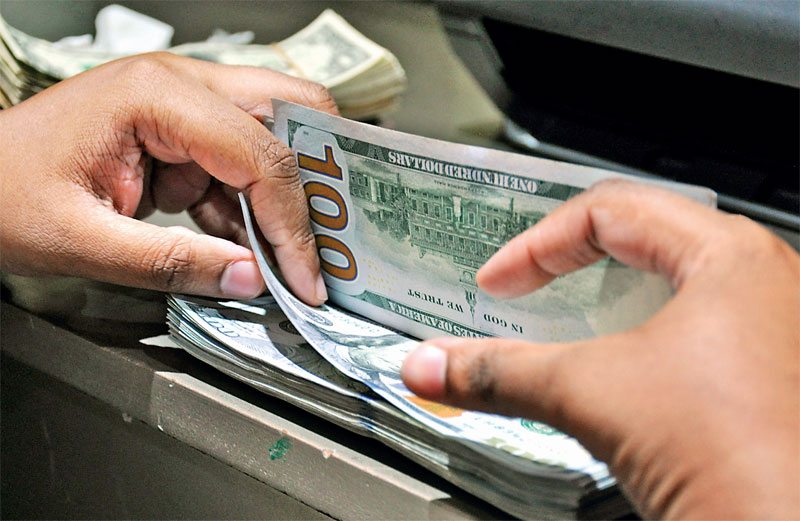Sunday Dec 14, 2025
Sunday Dec 14, 2025
Thursday, 10 February 2022 00:17 - - {{hitsCtrl.values.hits}}


Central Bank Governor Ajith Nivard Cabraal
 Until September last year the US Dollar (USD)-Sri Lanka Rupee (SLR) exchange rate was determined on the basis of a “managed float.” This meant that demand and supply of USD in the market were the primary determinants of the exchange rate. Official (Central Bank) market intervention, by way of sale or purchase of USD in limited quantities, smoothened out any large fluctuations in the exchange rate, when needed.
Until September last year the US Dollar (USD)-Sri Lanka Rupee (SLR) exchange rate was determined on the basis of a “managed float.” This meant that demand and supply of USD in the market were the primary determinants of the exchange rate. Official (Central Bank) market intervention, by way of sale or purchase of USD in limited quantities, smoothened out any large fluctuations in the exchange rate, when needed.
In September 2021 the Central Bank (CB) set an upper limit of Rs. 203 per USD that authorised dealers in foreign exchange, including banks, must adhere to for all foreign exchange transactions. This restriction, now in effect for five months, has had severe adverse impacts on the functioning of the Sri Lankan economy.
Since the demand for USDs has been higher than the supply of USDs at the upper limit of Rs. 203 per USD, the CB restriction essentially results in the exchange rate being “fixed” at this rate. Banks have been compelled to address this shortage, by restricting allocation of their inadequate USDs among customers for all permitted foreign expenditures, at this “fixed” rate. The shortage has worsened substantially over the past months. In response, the CB, while stubbornly maintaining the “fixed” rate, has issued a number of additional directives, which have failed to address the adverse consequences of this shortage, as detailed below.
When the demand for a foreign currency exceeds its supply in any country, the fixed official exchange rate does not allow market adjustment to reflect that difference. The natural consequence is the emergence of an alternative market for the currency in shortage, commonly termed a “black market.” Such a black market has recently developed in Sri Lanka with USDs “selling” in excess of Rs. 240 per USD compared with the “official” rate of Rs. 203.
Migrant remittances: Sri Lanka’s single largest source of USDs are remittances from migrant workers abroad, primarily in the Middle East. Informal currency transfer arrangements for workers in the Middle East from many South Asian countries (Pakistan, Bangladesh, Nepal, etc.) have been in place for decades, since many such workers did not have bank accounts in their home countries. These arrangements, termed “Hawala” and “Undiyal” are very reliable. Workers hand over foreign currency in the country where they work and the designated person in the home country is given the money in local currency at the agreed exchange rate.
In the past, most Sri Lankan workers did not resort to such arrangements because they had bank accounts in Sri Lanka to which they transferred their foreign earnings at a realistic official exchange rate. With the recent significant price difference between the official and black market rates for the USD, the Hawala/Undiyal arrangements have provided a ready alternate avenue for Sri Lankan workers. As more of these workers became aware of the alternate option, remittances through the banking system have declined precipitously, from $ 600-700 million per month, to $ 200-300 million per month.
The CB tried to reduce this decline by initially offering Rs. 2 per USD over the “official” rate for worker remittances, and later an additional Rs. 8 per USD. When remittances declined further, the Central Bank tried to “threaten” workers by saying that using alternate methods were illegal and may even be funding “drug dealing.” In November 2021, foreign worker remittances through official channels had declined by $ 340 million compared with November 2020. While the official exchange rate remains misaligned to market demand and supply, this loss will only increase as more workers become aware of alternate avenues. The adverse impact on Sri Lanka’s foreign exchange earnings will be a staggering $ 4 billion per year. This alone should be reason enough to dispense with the “fixing” of the exchange rate.
Export earnings: With the fixing of exchange rates, exporters have been delaying the repatriation of their export earnings for as long as possible, till the CB is finally forced to succumb to the pressure and let the currency float. The CB has introduced more and more regulations to push exporters to bring back these funds to Sri Lanka and mandatorily convert portions of these amounts to SLRs. Despite all CB regulations, the USDs officially coming into the country from exports is less than if the currency was allowed to find the level at which supply and demand balance.
Tourist earnings: With better control of the COVID-19 pandemic, tourist numbers have increased substantially in December and January, though not to pre-pandemic levels. When it became apparent that tourists too were converting their foreign currencies into SLRs in the black market, the CB required tourists to pay their bills at all registered tourist hotels and guest houses in foreign currency. The attractiveness of Sri Lanka as a tourist destination depends on the costs incurred by tourists in their own currencies. If they officially receive less SLRs for their currencies than with a realistic exchange rate, this will discourage some fraction of tourists from visiting Sri Lanka, which, in turn, will reduce tourist foreign currency inflows.
Shipping and airlines: As a result of the severe USD shortage, banks are restricting foreign exchange for local agents of shipping and air lines who seek foreign exchange to pay their principals for services provided, after collecting payments in SLRs from clients. Kuwait Airways has already stopped its flights to Sri Lanka. Others will also reduce flights if not paid for tickets sold or goods air freighted. Shipping lines will soon by-pass Sri Lanka as a destination if not paid for their services. The country will face severe economic repercussions from these trends.
Foreign investments: The Colombo Stock Exchange indices have grown significantly over the past year, totally on the back of local investors. Foreign investors have been very large net sellers. The original foreign investments were made on condition that the foreign investors could freely convert revenue from sale of shares and from dividends back to the currencies they originally brought in for investments. These sellers now face difficulty when trying to remit their sales proceeds in foreign currencies, because of the shortage. One can only imagine the negative impact this will have on investor confidence and any potential new investments.
“Illusory” benefit: The most often cited “benefit” of fixing the exchange rate at an artificially low rate is that this would control price increases in imported food and other consumer items. This is an illusion. Many importers can only obtain foreign exchange to import such items in the black market. The rates paid for such exchange is further increased beyond the open market rate because of another CB regulation (see below). When importers persuade banks to open LCs for imports and the banks are late in meeting their obligation to pay the LCs after the goods have arrived in the Port, importers incur large demurrage costs. This increases the final consumer price, even if the LC is paid for at the official exchange rate.
Foreign currency grab by CB: The CB has introduced a regulation in terms of which any bank which converts SLRs to foreign currency for one of its clients must give the CB foreign currency equivalent to 25% of the converted amount at the official rate. An importer desperate to obtain foreign exchange for any critical need, such as urgent spares to repair machinery, arranges to pay an exporter having USD a premium above the official rate, if the exporter agrees to bring in USD into the exporter’s local bank at the official rate. The importer then asks the same local bank to open an LC on his behalf and use the funds he has arranged for (although it is brought into the exporter’s account) to pay for the urgent import.
Because of the CB’s 25% regulation, the bank typically asks the importer to arrange for an extra 25% beyond the LC amount. This effectively means that instead of paying a premium of Rs. 37 (say) over Rs. 203, it costs the importer a further 25% (Rs. 9.25) per USD to fund his LC. In essence, the CB is now asking importers desperate for foreign exchange to purchase an additional 25% on behalf of the CB and to meet the cost of the premium; effectively a “black market” deal on behalf of the CB!
The CB has also, by decree, forced private banks to allocate a share of their limited foreign exchange for the import of fuel, for vehicles and for operating the CEB’s thermal power plants. LCs for such imports were previously opened through the two state banks, which no longer have sufficient funds for this purpose, because of the fixed exchange rate. This has further reduced the foreign exchange available to private banks to service their own customers.
It is abundantly clear to any person with a modicum of sense, although clearly not to the Central Bank, that its attempts to artificially control the exchange rate by dictate is having a massive adverse impact on the functioning of the economy, without any worthwhile offsetting benefits. Will the CB ever come to its senses and let the USD find its true rate to save the country from further misery?
(The writer is an economist
with extensive experience at
CEO level, in both public and
private sectors.)